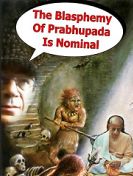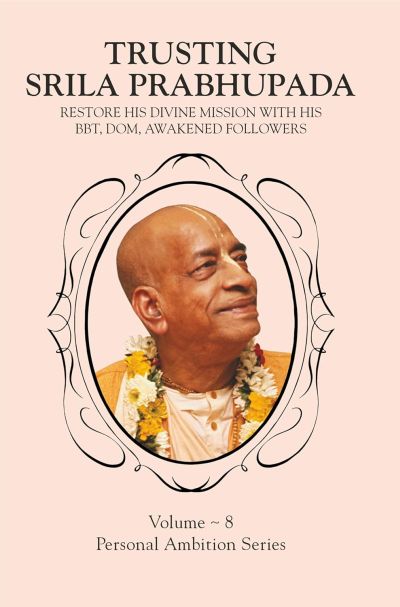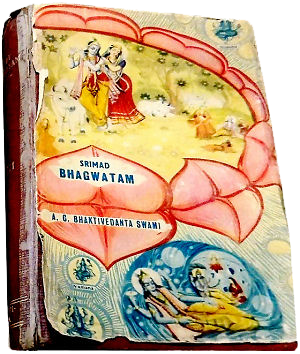The Beauty of Śrīmatī Rādhārāṇī
The following is a very beautiful verse from the Śrī Caitanya-caritamṛta, Madhya-lila 8.166, describing the beauty and fragrance of Śrīmatī Rādhārāṇī. The purport is a summary translation of the Śrī Premāmbhoja-maranda, a song composed by Śrīla Raghunātha dāsa Gosvāmī, which Kavirāja Gosvāmī quotes, and is given to us by Śrīla Prabhupāda, as described by Śrīla Bhaktivinoda Ṭhākura. The full song follows the text and purport.
Śrī Caitanya-caritamṛta 1975 Edition
By His Divine Grace A. C. Bhaktivedanta Swami Prabhupāda
(CC. Madhya 8.166)
rādhā-prati kṛṣṇa-sneha–sugandhi udvartana
tā’te ati sugandhi deha–ujjvala-varaṇa
rādhā-prati—toward Śrīmatī Rādhārāṇī; kṛṣṇa-sneha—the affection of Lord Kṛṣṇa; su-gandhi udvartana—perfumed massage; tā’te—in that; ati—very; su-gandhi—perfumed; deha—the body; ujjvala—brilliant; varaṇa—luster.
“Śrīmatī Rādhārāṇī’s transcendental body is brilliant in luster and full of all
transcendental fragrances. Lord Kṛṣṇa’s affection for Her is like a perfumed massage.
PURPORT: Sugandhi udvartana refers to a paste made of several perfumes and fragrant oils. This paste is massaged all over the body, and in this way the body’s dirt and perspiration are removed. Śrīmatī Rādhārāṇī’s body is automatically perfumed, but when Her body is massaged with the scented paste of Lord Kṛṣṇa’s affection, Her entire body is doubly perfumed and made brilliant and lustrous. This is the beginning of Kṛṣṇadāsa Kavirāja Gosvāmī’s description of Śrīmatī Rādhārāṇī’s transcendental body. This description is based on the book known as Premāmbhoja-maranda compiled by Śrī Raghunātha dāsa Gosvāmī. Śrīla Kavirāja Gosvāmī’s descriptions in verses 165-181 are based on this book. A translation of the original Sanskrit as described by Śrīla Bhaktivinoda Ṭhākura reads as follows:
“The love of the gopīs for Kṛṣṇa is full of transcendental ecstasy. It appears to be a brilliant jewel, and enlightened by such a transcendental jewel, Rādhārāṇī’s body is further perfumed and decorated with kuṅkuma. In the morning Her body is bathed in the nectar of compassion, in the afternoon in the nectar of youth, and in the evening in the nectar of luster itself. In this way the bathing is performed, and Her body becomes as brilliant as the cintāmaṇi jewel. Her dress is composed of various kinds of silken garments, which may be compared to Her natural shyness.
“Her beauty is more and more enhanced, being decorated with kuṅkuma, which is compared to beauty itself, and with blackish musk, which is compared to conjugal love. Thus Her body is decorated with different colors. The kuṅkuma is red, and the musk is black. Her ornaments embody the natural symptoms of ecstasy-trembling, tears, jubilation, stunning, perspiration, faltering of the voice, bodily redness, madness and dullness. In this way the entire body is bedecked with these nine different jewels. Over and above this, the beauty of Her body is enhanced by Her transcendental qualities, which hang as a flower garland on Her body. The ecstasy of love for Kṛṣṇa is known as dhīra and adhīra, sober and restless. Such ecstasy constitutes the covering of Śrīmatī Rādhārāṇī’s body, and it is adorned by camphor. Her transcendental anger toward Kṛṣṇa is embodied as the arrangement of the hair on Her head, and the tilaka of Her great fortune shines on Her beautiful forehead. The earrings of Śrīmatī Rādhārāṇī are the holy names of Kṛṣṇa, as well as the hearing of His name and fame. Her lips are always reddish due to the betel nut of ecstatic affection for Kṛṣṇa. The black ointment around Her eyes is Her tricky behavior with Kṛṣṇa brought about by love. Her joking with Kṛṣṇa and gentle smiling is the camphor with which She is perfumed. She sleeps in Her room with the aroma of pride, and when She lies down in Her bed, the transcendental variety of Her loving ecstasies is like a jeweled locket in the midst of Her necklace of separation. Her transcendental breasts are covered by Her sari in the form of affection and anger toward Kṛṣṇa. She has a stringed instrument known as a kacchapī-vīṇā, which is the fame and fortune that actually dries up the faces and breasts of the other gopīs. She always keeps Her hands on the shoulder of Her gopī friend, who is compared to Her youthful beauty, and although She is highly qualified with so many spiritual assets, She is nonetheless affected by the Cupid known as Kṛṣṇa. Thus She is defeated.
Śrīla Raghunātha dāsa Gosvāmī offers his respectful obeisances to Śrīmatī Rādhārāṇī, taking a straw in his mouth. Indeed, he prays, ‘O Gāndharvikā, Śrīmatī Rādhārāṇī, just as Lord Kṛṣṇa never rejects a surrendered soul, please don’t reject me.’ “ This is a summary translation of the Premāmbhoja-maranda, which Kavirāja Gosvāmī quotes. (CC. Madhya 8.166)
——
SONG LYRICS
Premāmbhoja Marandākhya Stava-rāja
Honey-sweet praises, flowing from the lotus-flower of love.
(by Śrīla Raghunātha dāsa Gosvāmī)
TEXT 1
mahā-bhāvojjvalac-cintā-ratnodbhāvita-vigrahām |
sakhī-praṇaya-sad-gandha-varodvartana-suprabhām || 1||
The love of the gopīs for Kṛṣṇa is full of transcendental ecstasy. It appears to be a brilliant jewel, and enlightened by such a transcendental jewel, Rādhā’s body is further perfumed and decorated with kuṅkuma. (1)
TEXT 2
kāruṇyāmṛta-vīcibhis tāruṇyāmṛta-dhārayā |
lāvaṇyāmṛta-vanyābhiḥ snapitāṁ glapitendirām || 2||
In the morning Her body is bathed in the nectar of compassion, in the afternoon in the nectar of youth, and in the evening in the nectar of luster itself. In this way the bathing is performed, and Her body becomes as brilliant as the cintāmaṇi jewel. She eclipses the goddess of fortune Lakṣmīdevī. (2)
TEXT 3
hrī-paṭṭa-vastra-guptāṅgīṁ saundarya-ghusṛṇāñcitām |
śyāmalojjvala-kastūrī-vicitrita-kalevarām || 3||
Her dress is composed of various kinds of silken garments, which may be compared to Her natural shyness. Her beauty is more and more enhanced, being decorated with kuṅkuma, which is compared to beauty itself, and with blackish musk, which is compared to conjugal love. Thus Her body is decorated with different colors. The kuṅkuma is red and the musk is black. (3)
TEXT 4
kampāśru-pulaka-stambha-sveda-gadgada-raktatāḥ |
unmādo jāḍyam ity etai rathanir navabhir uttamaiḥ || 4||
Her ornaments embody the natural symptoms of ecstasy: trembling, tears, jubilation, stunning, perspiration, faltering of the voice, bodily redness, madness, and dullness. In this way the entire body is bedecked with these nine different jewels. (4)
TEXT 5
klptālaṅkṛti-saṁsliṣṭāṁ guṇālī-puṣpa-mālinīm |
dhīrādhīrātva-sad-vāsa-paṭa-vāsaiḥ pariṣkṛtām || 5||
Over and above this, the beauty of Her body is enhanced by Her transcendental qualities, which hang as a flower garland on Her body. The ecstasy of love for Kṛṣṇa is known as dhīra and adhīra, sober and restless. Such ecstasy constitutes the covering of Śrī Rādhā’s body, and it is adorned by camphor. (5)
TEXT 6
pracchanna-māna-dhammillāṁ saubhāgya-tilakojjvalām |
kṛṣṇa-nāma-yaśaḥ-śrāva-vataṁsollāsi-karṇikām || 6||
Her transcendental anger toward Kṛṣṇa is embodied as the arrangement of the hair on Her head, and the tilaka of Her great fortune shines on Her beautiful forehead. The earrings of Śrī Rādhā are the holy names of Kṛṣṇa, as well as the hearing of His name and fame. (6)
TEXT 7
rāga-tāmbūla-raktauṣṭhīṁ prema-kauṭilya-kajjalām |
narma-bhāṣita-nisyanda-smita-karpūra-vāsitām || 7||
Her lips are always reddish due to the betelnut of ecstati affection for Kṛṣṇa. The black ointment around Her eyes is Her tricky behavior with Kṛṣṇa brought about by love. Her joking with Kṛṣṇa and gentle smiling is the camphor with which She is perfumed. (7)
TEXT 8
saurabhāntaḥ-pure garva-paryaṅkopari līlayā |
niviṣṭāṁ prema-vaicittya-vicalat-taralāñcitām || 8||
She sleeps in Her room with the aroma of pride, and when She lies down in Her bed, the transcendental variety of Her loving ecstasies is like a jeweled locket in the midst of Her necklace of separation. (8)
TEXT 9
praṇaya-krodha-sac-colī-bandha-guptī-kṛta-stanām |
sapatnī-vaktra-hṛc-choṣi-yaśaḥ-śrī-kacchapī-ravām || 9||
Her transcendental breasts are covered by Her sari in the form of affection and anger toward Kṛṣṇa. She has a stringed instrument known as a kacchapī-vīṇā, which is the fame and fortune that actually dries up the faces and breasts of the other gopīs. (9)
TEXT 10
madhyatātma-sakhī-skandha-līlānyasta-karāmbujām |
śyāmāṁ śyāma-smarāmoda-madhūlī-pariveśikām || 10||
She always keeps Her hands on the shoulder of Her gopī friend, who is compared to Her youthful beauty, and although She is highly qualified with so many spiritual assets, She is nonetheless affected by the Cupid known as Kṛṣṇa. Thus She is defeated. (10)
TEXT 11
tvāṁ natvā yācate dhṛtvā tṛṇaṁ dantair ayaṁ janaḥ |
sva-dāsyāmṛta-sekena jīvayāmuṁ suduḥkhitam || 11||
O Śrī Rādhā, this person offers respectful obeisances unto You, taking a straw in his mouth. This person is very unhappy. Please bring him to life by sprinkling him with the nectar of service to You. (11)
TEXT 12
na muñcec charaṇāyātam api duṣṭaṁ dayāmayaḥ |
tato gāndharvike hā hā muñcainaṁ naiva tādṛśam || 12||
O Gāndharvikā, Śrī Rādhā, just as Lord Kṛṣṇa never rejects a surrendered soul, please don’t reject me. (12)
TEXT 13
premāmbhoja-marandākhyaṁ stava-rājam imaṁ janaḥ |
śrī-rādhikā-kṛpā-hetuṁ paṭhaṁs tad-dāsyam āpnuyāt || 13||
A person who recites this prayer called ‘Śrī Premāmbhoja-maranda‘ (the honey from the love-lotus), which is meant to arouse Śrī Rādhikā’s mercy, will attain Her devotional service. (13)
——-
COMMENTS FROM CAITANYA CARITAMṚTA
Śrīla Raghunātha has named this stava Premāmbhoja Marandākhya Stava-rāja, or the king of praises, that flows like honey from the lotus flower of divine love.
This is the king of all stavas in the Stavāvalī-compilation, for it defines the constitution of Śrī Rādhikā, who is the very form of mahā bhāva, which is the essence of prema. Only someone who has prema can understand the truth about Rādhārāṇī.
Śrīmatī Rādhārāṇī is the embodiment of prema, and Her body consists of nothing but prema.
premera ‘svarūpa-deha’–prema-vibhāvita
kṛṣṇera preyasī-śreṣṭhā jagate vidita
“The body of Śrīmatī Rādhārāṇī is a veritable transformation of love (prema) of Godhead; She is the dearmost friend of Kṛṣṇa, and this is known throughout the world. (CC Madhya 8.162)
mahābhāva-svarūpā śrī-rādhā-ṭhākurāṇī
sarva-guṇa-khani kṛṣṇa-kāntā-śiromaṇi
Śrī Rādhā Ṭhākurāṇī is the embodiment of mahābhāva. She is the repository of all good qualities and the crest jewel among all the lovely consorts of Lord Kṛṣṇa.
PURPORT: The unadulterated action of the hlādinī-śakti is displayed in the dealings of the damsels of Vraja and Śrīmatī Rādhārāṇī, who is the topmost participant in that transcendental group. The essence of the hlādinī-śakti is love of Godhead, the essence of love of Godhead is bhāva, or transcendental sentiment, and the highest pitch of that bhāva is called mahābhāva. Śrīmatī Rādhārāṇī is the personified embodiment of these three aspects of transcendental consciousness. She is therefore the highest principle in love of Godhead and is the supreme lovable object of Śrī Kṛṣṇa. (CC Adi 4.69)
Śrīla Bhaktisiddhānta Sarasvatī Ṭhākura quotes Rūpa Gosvāmī as follows: “The loving propensity of the āśraya (devotee) toward the viṣaya (Lord) becomes so ecstatic that even after enjoying the company of the beloved, the devotee feels that his enjoyment is insufficient. At such a time, the lover sees the beloved in different ways. Such a development of ecstasy is called anurāga. When anurāga reaches its highest limit and becomes perceivable in the body, it is called bhāva. When the bodily symptoms are not very distinct, however, the emotional state is still called anurāga, not bhāva. When bhāva ecstasy is intensified, it is called mahā-bhāva. The symptoms of mahā-bhāva are visible only in the bodies of eternal associates like the gopīs.” (CC Madhya 6.13, Purport)
Caitanya Mahāprabhu displayed that mahā-bhāva. That mahā-bhāva is not possible for ordinary man. It is especially prerogative of Śrīmatī Rādhārāṇī and who played the part of Rādhārāṇī, although He’s Kṛṣṇa, Caitanya Mahāprabhu. So mahā-bhāva, the ecstasies, that is not to be imitated by us, but to be aware of this fact that how mahā-bhāgavata, mahā-bhāva, they treat with Kṛṣṇa. So generally, advancement, especially those who are preachers, they should remain on the second platform. Even a mahā-bhāgavata, when he becomes preacher, he comes down to the second platform. He does not remain on the topmost platform. He plays the part of second platform. And sometimes it is stated in the Bible, I think, that Jesus Christ said, “I had many things to say, but I am not saying.” (The Nectar of Devotion — Vrndavana, October 23, 1972)
“Śrīla Raghunātha dāsa Gosvāmī offers his respectful obeisances to Śrīmatī Rādhārāṇī, taking a straw in his mouth. Indeed, he prays, ‘O Gāndharvikā, Śrīmatī Rādhārāṇī, just as Lord Kṛṣṇa never rejects a surrendered soul, please don’t reject me.’” This is a summary translation of the Premāmbhoja-maranda, which Kavirāja Gosvāmī quotes. (CC. Madhya 8.166)








Speak Your Mind